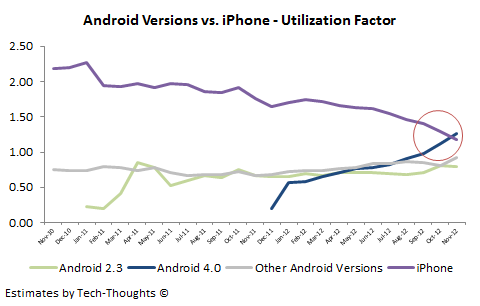Two months ago, I calculated the growth in "utilization factor" of various android versions by measuring the ratio of their browser usage share (measured by NetApplications) to installed base share (from Google's version data). The data showed that browser usage on Android 4.0 was steadily outpacing that of other Android versions. Based on this, I surmised that the "engagement gap" between Android and the iPhone would soon begin to close. Let's take a look at the current state of that gap.
1) Since NetApplications is the only provider that provides usage data based on operating system version, there is no way to verify this trend from multiple sources
2) There is no way to segregate Android usage data between smartphones and tablets
3) While it shows the utilization pattern across various Android versions, it does not compare this to the iPhone
For now, there isn't much we can do about the first problem, but there are solutions to the other two. The only major tablet to be launched with Android 4.0 was the Kindle Fire HD, which was launched in September 2012. Therefore, the impact of tablets on Android 4.0 utilization is unlikely to be material, given the small install base (relative to smartphones), at least until September 2012. And finally, the last problem is a bit of a red herring - utilization factor is a relative measure, not absolute (ratio of usage share to install base share). This means that an increase in utilization of one android version, without a corresponding decrease in another, leads to a decrease in the utilization of competing platforms. This does not mean that the absolute usage of the iPhone has reduced, but it means that its usage share (with install base normalized for each OS version) has reduced.
So how do we measure the iPhone's utilization rate relative to Android 4.0? The easiest way would be to incorporate ComScore's US installed base data (available until November 2012). Since NetApplications' usage data is skewed to the US market and the split of Android versions in the US is unlikely to show wide variation, the results should be reliable. Now, all we have to do is measure the installed base share of the iPhone and various Android versions and use these as the denominators for the respective usage shares.
The chart above clearly shows that Android 4.0's utilization rate has surpassed that of the iPhone. Even if we ignore the data after September 2012 (owing to the Kindle Fire HD launch), we can see that the utilization is at least comparable. The drop in Android 4.0 usage is likely to have a negative impact in the utilization rate in December, but as the first chart showed, this has been made up by an increase in Android 4.1/4.2 usage.
Based on this, I would have to conclude that the browser engagement gap between Android and the iPhone is a thing of the past. The next step is to measure the state of the engagement gap between Android tablets and the iPad, but that data may be more difficult to come by.









